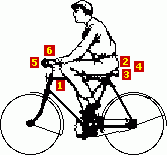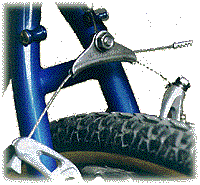This is a short primer on how to buy inexpensive used bikes for basic commuting or transportation (no more than about 10 miles a day). It’s not for people biking longer distances, or who want a high-quality bike, or who will be doing mountain biking, racing, or touring.
Where to buy them
Most bike shops don’t sell used bikes, but some do, and a bike shop is the best place to buy a used bike, because it should already be adjusted to run correctly. Buy a used bike anywhere else and then you’re faced with the unknown cost of having a bike shop tune it up and replace any necessary parts. Refer the list of used bike sellers at the bottom of this article.
(Of course, if you know how to fix up a bike yourself, then you can get a better deal if you buy your bike from a thrift store or from classified ads, but if you knew how to fix up a bike you probably wouldn’t be reading this guide…)
Bike Fit
 The most important part of buying a used bike is getting one that fits you. A bike that’s uncomfortable will make cycling a chore. Even if it’s a little bit uncomfortable, it’ll be a LOT uncomfortable after being on it for half an hour. The most important things are to make sure that the handlebars are higher than the seat so you’re not hunched over them, and that there’s at least at least a couple of inches between the top tube and your crotch when you’re standing on the ground, straddling the bike. Check out our detailed guide to bike fit for more.
The most important part of buying a used bike is getting one that fits you. A bike that’s uncomfortable will make cycling a chore. Even if it’s a little bit uncomfortable, it’ll be a LOT uncomfortable after being on it for half an hour. The most important things are to make sure that the handlebars are higher than the seat so you’re not hunched over them, and that there’s at least at least a couple of inches between the top tube and your crotch when you’re standing on the ground, straddling the bike. Check out our detailed guide to bike fit for more.
Identifying Brands
I’m sure I’ll catch flak for saying this, but there’s nothing wrong with riding a cheap, department-store bike for getting around town. Sure, I ride a $600 bike now, but I rode a $73 Huffy from Target all through college, ten miles a day, and it lasted me fine for a few years. Sure, it only lasted a few years, but that’s less than $25/yr.
But you should at least know what makes a department-store (DS) bike lesser quality.
- Weight. DS bikes are made entirely from steel, so they’re a little heavier. Brand-name bikes are often made with aluminum or lighter alloys.
- Strength. The frame on DS bikes (especially older ones) is typically crimped together instead of welded. This may only be a problem if you carry a lot of weight or bounce down curbs a lot, in which case it could come apart. (It came apart on my old bike because I was routinely hauling lots of groceries, but I was able to fix it by drilling a hole through the pieces and securing them with a bolt.)
- Assembly. Bike-store bikes are assembled by trained professionals who know what they’re doing. DS bikes are put together by some toy department employee who makes minimum wage and has no professional training. Sure, it’s not too hard to put a bike together, but if you’re getting a DS bike you’ll probably want to get it checked out by a professional to make sure the wheels aren’t about to come off and that the brakes work right. Safety matters.
- Components. The brakes and derailleurs (gear-shifters) are generally lower quality on DS bikes and may need to be replaced sooner. But this is no big deal — on any used bike you’re probably going to have to replace them eventually, and you can always replace them with good parts when you do. Do make sure that the bike you’re looking at hasn’t been subject to a recall, or if it has, that you get a bike shop to fix the problem.
Here are some popular brands of DS bikes vs. bike-shop bikes.
| Department Store Bikes | Bike Shop Bikes |
|---|---|
| Huffy, Murray, Next, Roadmaster, Free Spirit, Pacific Cycle | Diamondback, Cannondale, Giant, Jamis, Raleigh, Schwinn, Specialized, Trek, Univega |
Speeds

If the terrain where you’ll be riding is relatively flat then a one-speed bike may work fine for you, as long as that one speed is a comfortable speed. But if you have any hills, you’ll want at least three speeds, though 10 is better. Most modern bikes have 18 or 21 speeds, but it’s kind of overkill, since most people don’t even use all 10 speeds on a 10-speed bike. There’s nothing wrong with a bike with 15, 18, or 21 speeds, it’s just not that big an advantage over 10.
Most bikes have gears in front and gears in back. If you have three in front and five in back, then that’s 15 speeds total (3×5). Some bikes have a hub inside the rear wheel where you can’t see it, but you’ll know it’s a hub because a cable runs from it to the handlebar where the shifters are. Hubs are either 3 or 7 speeds.
Brakes
Most bikes have hand brakes, with brake levers on the handlebars, one for each wheel. You want both brakes to be working, because if you have only one brake, and you’re going down a hill, and your one good brake snaps, then you’re toast. If the bike you’re looking at has only one working hand brake, a bike shop can fix one or add another one for you.
There are three main kinds of brakes. V-brakes give excellent braking power and are easy to adjust, and they’re worth looking for. Center-pull brakes are the next best. In last place are side-pull brakes which are often lower quality and harder to adjust. (There are some high-quality side-pull brakes out there, but if you’re looking at cheap bikes you’re unlikely to run across them.) Side-pull aren’t used very much on consumer bikes any more, but ALL bikes used to have them, so if you’re looking at used bikes you’re liable to run across them.
Most single-speed bikes have a coaster brake, meaning you pedal backwards to brake. This is fine, though you’ll probably want one hand brake as well.
| V-Brakes (best) | |
|---|---|
 |  |
| Center-Pull (okay) | Side-Pull (hmm…) |
 |  |
Safety
By law, all new bikes have to have front and rear reflectors, but they may be missing from used bikes. If your bike doesn’t have them, make sure you get them from a bike shop. If you’re riding at night, you’ll also want front and rear lights.
Rejuvenating Old Bikes
Old bikes which have been neglected can give a very harsh ride, but there are four things you can do which can go a long way to improving the ride.
Air up the tires. If the tires are soft, it’ll be twice as hard to pedal. I can’t overemphasize this point enough. Make sure your tires are properly inflated unless you want biking to be a real chore. Pump them up until you can just barely make the slightest dent in the tire by pressing it with your thumb.
Oil the
Make sure the brakes aren’t rubbing. If the brake pads are rubbing against the wheel rim, it’ll slow you down. Adjust the brakes so they’re not rubbing, if you need to.
Replace knobby tires with slick tires. Mountain-bike tires with large, coarse knobs are great for off-road riding, but they slow you down on pavement. Replacing knobby tires with smooth tires will make you go faster for less effort.
Tune-Ups

If the bike doesn’t ride the way you want it to, or anything’s broken, or it’s missing parts, it can be worth having a bike shop give it a tune-up. Be careful to ask the shop for the maximum cost for anything they’re going to do to the bike beforehand, or ask them to call you before they replace any parts, because if the bike is in really bad shape, replacing all the parts on it could wind up costing you more than a new bike.
One thing that old bikes often need is to have the wheels trued, meaning tightening & loosening various spokes so that the wheel spins straight. A wheel that wobbles left and right will run into your brakes every revolution and slow you down.
Maintenance
If you can store the bike out of the rain it won’t need much maintenance. Here are the basics.
Tires. Check the air pressure a couple of times a month, and add air as necessary.
Brakes. Check the brakes once a month to make sure they’re not rubbing.
Outside of these things, just take your bike in to a shop about once a year for a tune-up. They’ll oil the
Online Ads
- See the click-to-order used bike inventory at Waterloo Cycles, with free shipping to the continental U.S
Thanks for reading. Good luck finding a bike! 🙂








